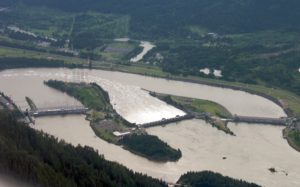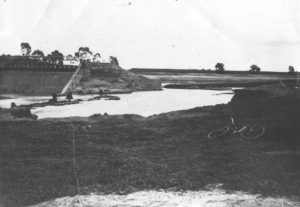This is a day for dams—or against dams. In the U.S., on August 8, 1937, the Bonneville Dam on the Columbia River began generating power. The Bonneville Dam was the first on the river, part of President Franklin Roosevelt’s New Deal programs, bringing jobs and electricity to the Pacific Northwest. Dams generate huge benefits in terms of water availability, electricity and flood prevention.

But 38 years later, on August 8, 1975, another truth about dams proved itself in central China—dams are dangerous. On that day, the Banqiao Reservoir Dam collapsed, devastating the people and landscape of Henan Province.
China has always been plagued by severe flooding, causing human tragedy year after year. During the 1950s, the Chinese government began an ambitious program of dam building to control that flooding while also producing electricity and providing irrigation water for agriculture. A principal target of dam building was the Yellow River watershed, the second longest river in China and central to the history and economy of the nation. Hundreds of dams were built in the watershed.
Among them was the Banqiao Reservoir Dam on the Ru River, a tributary of the Yellow. It was an earthen dam, nearly 400 feet high, impounding a large reservoir behind it. The dam was built to withstand a 1000-year flood, one caused by half a meter of rain over a three-day period. Over the years, the dam experienced some structural problems, but Soviet engineers reinforced the dam, calling it then an “iron dam,” incapable of failing.
But in August of 1975, Typhoon Nina settled over the area. In three days, one meter of rain fell, twice the engineered capacity of the dam. As the rains continued and the water rose behind the dam, workers heroically piled sand bags atop the dam. Their efforts were unsuccessful, however, and the dam began to fail. One worker cried, “Chu Jiaozi”—“The river dragon has come!”
Just after midnight on August 8, the dam collapsed. A wall of water 30 feet high and 7 miles wide rushed downstream at 30 miles per hour. An entire village, Daowencheng, below the dam was obliterated, killing nearly 9,600 residents. In five hours, the entire reservoir drained. Downstream dams could not contain the water and began failing. More than 60 dams collapsed in all.
More than 25,000 people died directly from the flood, but as many as 220,000 died subsequently from contaminated water and famine associated with the dam failures. Nearly 6 million buildings were destroyed, leaving 11 million people homeless or otherwise displaced. The total loss of life and property makes the Banqiao Dam failure the most disastrous in history.
Dams produce great value in modern civilization, controlling floods, storing water for human use and irrigation, and producing electricity. We can’t seem to live without them. Although construction of large dams in the U.S. has ground to a halt, the developing world continues to build dams at a rapid rate. China rebuilt the Banqiao Reservoir Dam soon after the tragedy, completing it in 1993.

As the largest human modifications to the landscape, however, storing massive quantities of water behind equally massive concrete or earthen walls, dams also inevitably create danger. Dams fail regularly—one storm in North Carolina in 2016, Hurricane Matthew, produced 17 dam failures. Eventually, as that anonymous dam worker foretold in 1975, the river dragon will come again.
References:
Encyclopedia Britannica. Typhoon Nina-Banqiao dam failure. Available at: https://www.britannica.com/event/Typhoon-Nina-Banqiao-dam-failure. Accessed June 8, 2018.
Environmental Justice Atlas. Banqiao dam failure in 1975, Henan, China. Available at: https://ejatlas.org/conflict/baquio-dam-failure-henan-china. Accessed June 8, 2018.
Watkins, Thayer. The Catastrophic Dam Failures in China in August 1975. San Jose State University, Department of Economics. Available at: http://www.sjsu.edu/faculty/watkins/aug1975.htm. Accessed June 8, 2018.
ngham, William F. Bonneville Dam. The Oregon Encyclopedia. Available at: https://oregonencyclopedia.org/articles/bonneville_dam/#.WxqnUEgvxRY. Accessed June 8, 2018.
